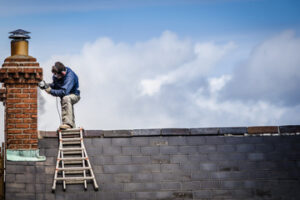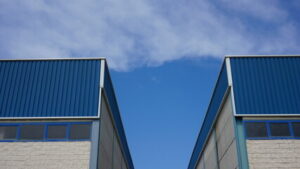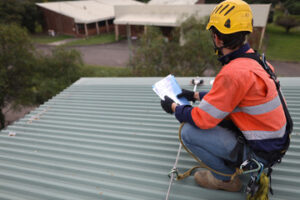Roofing Contractors Egg Harbor Township NJ can help you repair and replace your roof. However, choosing the right one is crucial. You want to hire someone who will do high-quality work that lasts.

Beware of roofers who are here one day and gone the next. These roofers usually charge low prices, but their work is shoddy and not worth the money.
Roofing Contractors have years of hands-on experience working on roofs and know how to work safely. They are also familiar with the different materials that go into roofing and how to properly install them. In addition, a good roofer knows how to repair and replace other parts of your home’s exterior, such as windows or siding. Often, a roofing contractor will have multiple crews that specialize in different types of home improvement projects.
Unlike general contractors, who often have a variety of skill sets and are not experts in one type of construction, a professional roofer can be the best choice for your re-roofing project. Not only do they have experience working on roofs, but they also know how to handle all the other aspects of the job, such as handling and disposing of all the discarded building materials.
A reputable roofing contractor will be licensed by your state or municipality. This is usually a simple process and requires passing an exam. A roofer’s license can be a sign of quality work, and a way for homeowners to verify that the contractor is a legitimate business.
It is important for homeowners to understand that a roofing contractor should be able to provide you with a written estimate before any work begins. This is the first step in protecting yourself from shady roofing contractors. They will charge your insurance company for products and add-ons that are not needed, just to maximize your claim.
A professional roofing contractor will be able to provide you with a detailed, accurate estimate for the entire job. It will include the labor and material costs, as well as any potential additional expenses such as debris removal or permit fees. Typically, a roofing contractor will also be able to provide you with a list of references from previous clients that can attest to the quality of their work. This will help you decide if the contractor is a good fit for your project.
Licensing
Roofing contractors are licensed professionals who understand the ins and outs of the job. They are able to handle the many aspects of a project, including determining how much materials are needed, handling the debris, and ensuring that all regulations are met. Having this level of experience allows them to deal with unexpected problems and ensure that the project is completed on time and within budget.
Depending on the area and state in which you work, licensing requirements may include passing an exam demonstrating your knowledge of the industry as well as business and law. Licensing agencies typically offer resources to help you prepare for these exams. In addition, the licensing requirements for a roofing contractor may vary by county.
There are also different insurances that may be required for a roofing contractor to have in place. This can include liability coverage, worker’s compensation coverage, and general business insurance. Some states require that a roofing contractor be bonded as well. The specific types of insurance needed varies by region and state, but having the appropriate policies in place is essential for any contractor to have.
When choosing a roofing contractor, be sure to ask for references and do a background check. Often, roofing contractors will be able to provide you with references from previous clients who can attest to their quality of work and customer service skills. Moreover, you should also determine whether the roofing contractor uses subcontractors or performs the work themselves.
The state requires that any construction work worth more than $2,500 be performed by a licensed roofing contractor. The state’s licensing board requires roofing contractors to pass a trade exam and a business and law exam. They must also demonstrate at least two years of experience in the field, as well as a valid certificate of insurance. In addition, any roofing contractor in the state is required to register with the state’s Contractors Board. This registration process includes a background check, an interview with the Board, and proof of insurance.
Insurance
Roofing contractors are required to carry certain types of insurance to cover operational risks. This includes general liability, workers’ compensation and commercial auto. Additionally, roofing contractors should have cyber liability insurance to pay for costs related to data breaches and hacking.
General liability insurance covers third-party bodily injury. This is a common risk for many businesses because it is easy for falling tools or debris to injure passersby on the job site. Roofing insurance may cover medical, rehabilitation and replacement cost for the victim. It can also cover legal costs. Property damage insurance is another important coverage to have as a roofing contractor. Falling shingles or other debris could cause damage to the home of the owner or nearby vehicles. A property damage policy can cover repair or restoration costs.
In addition to general liability, a roofing contractor should have a business owners policy (BOP). A BOP bundles three essential coverages into one policy and usually costs less than buying them separately. BOPs are especially helpful for smaller construction businesses that have to buy multiple policies.
Almost all states require roofing contractors to carry workers’ compensation insurance for employees. This insurance pays for treatment costs, missed wages and death benefits if a worker is injured on the job. It is also mandatory for most small businesses to have workers’ comp in order to be able to bid on government contracts.
If a roofer uses his or her personal vehicle to transport equipment or materials to work sites, a commercial auto insurance policy is necessary. This type of policy covers the vehicle and its contents in case they are stolen or damaged. Often, the commercial auto policy can be combined with the workers’ compensation insurance to save money.
Lastly, a roofing contractor should have tool and equipment insurance, also known as a “tool floater.” This type of policy covers the tools needed to operate a roofing business. It can also be combined with a commercial property policy to save money. A roofing contractor should also consider purchasing a surety bond. A surety bond is not technically an insurance policy, but it does provide work guarantees that help a hiring company feel confident about the roofing contractor’s abilities.
Reputation
Many customers look to friends and family for suggestions about local businesses, but others turn to the Internet. The Internet is a rich resource for customer reviews, and many potential customers will read feedback before hiring a roofing contractor. This makes it important to build a positive online reputation for your business. Authentic, positive customer reviews will increase your credibility and trustworthiness, and they can also boost your conversion rate.
There are a few important factors to consider when choosing a roofer, such as price, quality of work, and whether the company is reputable and will still be around after the job is complete. You may find that one company is cheaper than another, but you should always choose a company with the highest quality of work. If you choose a cheap contractor, you might have to pay more money to repair mistakes later on.
Another factor to consider when choosing a roofing contractor is how long the company has been in business. If a company is new, it might not have a lot of reviews yet. However, if a company has been in business for a long time, it is likely to have a good reputation and a strong business model.
When you are selecting a roofing contractor, it is important to make sure that they provide a written estimate upfront. This is a sign of professionalism and will help you to avoid shady contractors. Shady contractors will often avoid giving homeowners a written estimate, which is an indicator that they are not trustworthy. They might also charge your insurance company for products and add-ons that are not necessary, in order to maximize their profits.
Another way to encourage customers to leave a review for your roofing business is to put a request for reviews on your invoices and receipts. This is a simple, effective way to get more reviews and boost your reputation. You can even use an email autoresponder to remind your customers to leave a review. Adding this reminder to your invoices will ensure that every customer has the opportunity to leave a review.


